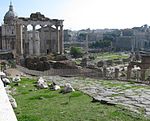Temple of Portunus
1st-century BC religious buildings and structuresBuildings and structures completed in the 1st century BCConversion of non-Christian religious buildings and structures into churchesDeconsecrated Roman Catholic churches in RomeRoman temples by deity ... and 2 more
Rome R. XII RipaTemples of the Forum Boarium

The Temple of Portunus (Italian: Tempio di Portuno) or Temple of Fortuna Virilis ("manly fortune") is a Roman temple in Rome, Italy, one of the best preserved of all Roman temples. Its dedication remains unclear, as ancient sources mention several temples in this area of Rome, without saying enough to make it clear which this is. It was called the Temple of Fortuna Virilis from the Renaissance, and remains better known by this name. If dedicated to Portunus, the god of keys, doors and livestock, and so granaries, it is the main temple dedicated to the god in the city.
Excerpt from the Wikipedia article Temple of Portunus (License: CC BY-SA 3.0, Authors, Images).Temple of Portunus
Via di Ponte Rotto, Rome Municipio Roma I
Geographical coordinates (GPS) Address Nearby Places Show on map
Geographical coordinates (GPS)
| Latitude | Longitude |
|---|---|
| N 41.889166666667 ° | E 12.480833333333 ° |
Address
Foro Boario
Via di Ponte Rotto
00153 Rome, Municipio Roma I
Lazio, Italy
Open on Google Maps










